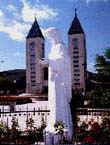



Thank you and may God Bless You!
Hosanna in the Highest


Marian Apparitions





In Fatima, Our Lady of the Rosary, is an approved apparition site which took place in 1917. The apparitions in Medjugorje as Our Lady, Queen of Peace, are considered alleged as the apparitions are still ocurring, since 1981 in the small village. Concerning pilgrimages to Medjugorje which take place in a private manner, the Congregation for the Doctrine of the Faith holds that they are permitted, on the condition that they not be considered a validation of events in progress and which still call for examination by the Church. Millions of people have passed through Medjugorje and many conversions and unexplained phenomena have taken place and is continuing to this day. Other approved apparition sites include Our Lady of the Immaculate Conception (1858) in Lourdes, France and Our Lady of Guadalupe (1531) in Mexico. For information (as of April 1999) concerning the status of other apparitions, visit: Apparitions.org
The Marian Information Center of Las Vegas encourages prayer and the practice of the Roman Catholic Faith in conformity with the teaching and absolute authority of the Holy Father, Pope John Paul II and his successors.
by Cardinal Ratzinger on the Theological Commentary on Fatima, Third Secret
(Excerpted portion, June 2000)
The teaching of the Church distinguishes between “public Revelation”and “private revelations”. The two realities differ not only in degree but also in essence. The term “public Revelation” refers to the revealing action of God directed to humanity as a whole and which finds its literary expression in the two parts of the Bible: the Old and New Testaments. It is called “Revelation” because in it God gradually made himself known to men, to the point of becoming man himself, in order to draw to himself the whole world and unite it with himself through his Incarnate Son, Jesus Christ. It is not a matter therefore of intellectual communication, but of a life-giving process in which God comes to meet man. At the same time this process naturally produces data pertaining to the mind and to the understanding of the mystery of God. It is a process which involves man in his entirety and therefore reason as well, but not reason alone. Because God is one, history, which he shares with humanity, is also one. It is valid for all time, and it has reached its fulfilment in the life, death and resurrection of Jesus Christ. In Christ, God has said everything, that is, he has revealed himself completely, and therefore Revelation came to an end with the fulfilment of the mystery of Christ as enunciated in the New Testament.
To explain the finality and completeness of Revelation, the Catechism of the Catholic Church quotes a text of Saint John of the Cross: “In giving us his Son, his only Word (for he possesses no other), he spoke everything to us at once in this sole Word—and he has no more to say... because what he spoke before to the prophets in parts, he has now spoken all at once by giving us the All Who is His Son. Any person questioning God or desiring some vision or revelation would be guilty not only of foolish behaviour but also of offending him, by not fixing his eyes entirely upon Christ and by living with the desire for some other novelty” (No. 65; Saint John of the Cross,The Ascent of Mount Carmel, II, 22).
Because the single Revelation of God addressed to all peoples comes to completion with Christ and the witness borne to him in the books of the New Testament, the Church is tied to this unique event of sacred history and to the word of the Bible, which guarantees and interprets it. But this does not mean that the Church can now look only to the past and that she is condemned to sterile repetition. The Catechism of the Catholic Church says in this regard: “...even if Revelation is already complete, it has not been made fully explicit; it remains for Christian faith gradually to grasp its full significance over the course of the centuries” (No. 66). The way in which the Church is bound to both the uniqueness of the event and progress in understanding it is very well illustrated in the farewell discourse of the Lord when, taking leave of his disciples, he says: “I have yet many things to say to you, but you cannot bear them now. When the Spirit of truth comes, he will guide you into all the truth; for he will not speak on his own authority... He will glorify me, for he will take what is mine and declare it to you” (Jn 16:12-14). On the one hand, the Spirit acts as a guide who discloses a knowledge previously unreachable because the premise was missing— this is the boundless breadth and depth of Christian faith. On the other hand, to be guided by the Spirit is also “to draw from” the riches of Jesus Christ himself, the inexhaustible depths of which appear in the way the Spirit leads. In this regard, the Catechism cites profound words of Pope Gregory the Great: “The sacred Scriptures grow with the one who reads them” (No.94; Gregory the Great,Homilia in Ezechielem I, 7, 8).
The Second Vatican Council notes three essential ways in which the Spirit guides in the Church, and therefore three ways in which “the word grows”: through the meditation and study of the faithful, through the deep understanding which comes from spiritual experience, and through the preaching of “those who, in the succession of the episcopate, have received the sure charism of truth” (Dei Verbum, 8). In this context, it now becomes possible to understand rightly the concept of “private revelation”, which refers to all the visions and revelations which have taken place since the completion of the New Testament. This is the category to which we must assign the message of Fatima. In this respect, let us listen once again to the Catechism of the Catholic Church: “Throughout the ages, there have been so-called ‘private' revelations, some of which have been recognized by the authority of the Church... It is not their role to complete Christ's definitive Revelation, but to help live more fully by it in a certain period of history”(No. 67). This clarifies two things:
1. The authority of private revelations is essentially different from that of the definitive public Revelation. The latter demands faith; in it in fact God himself speaks to us through human words and the mediation of the living community of the Church. Faith in God and in his word is different from any other human faith, trust or opinion. The certainty that it is God who is speaking gives me the assurance that I am in touch with truth itself. It gives me a certitude which is beyond verification by any human way of knowing. It is the certitude upon which I build my life and to which I entrust myself in dying.
2. Private revelation is a help to this faith, and shows its credibility precisely by leading me back to the definitive public Revelation. In this regard, Cardinal Prospero Lambertini, the future Pope Benedict XIV, says in his classic treatise, which later became normative for beatifications and canonizations: “An assent of Catholic faith is not due to revelations approved in this way; it is not even possible. These revelations seek rather an assent of human faith in keeping with the requirements of prudence, which puts them before us as probable and credible to piety”. The Flemish theologian E. Dhanis, an eminent scholar in this field, states succinctly that ecclesiastical approval of a private revelation has three elements: the message contains nothing contrary to faith or morals; it is lawful to make it public; and the faithful are authorized to accept it with prudence (E. Dhanis,Sguardo su Fatima e bilancio di una discussione, in La Civiltà Cattolica 104 [1953], II, 392-406, in particular 397). Such a message can be a genuine help in understanding the Gospel and living it better at a particular moment in time; therefore it should not be disregarded. It is a help which is offered, but which one is not obliged to use.
The criterion for the truth and value of a private revelation is therefore its orientation to Christ himself. When it leads us away from him, when it becomes independent of him or even presents itself as another and better plan of salvation, more important than the Gospel, then it certainly does not come from the Holy Spirit, who guides us more deeply into the Gospel and not away from it. This does not mean that a private revelation will not offer new emphases or give rise to new devotional forms, or deepen and spread older forms. But in all of this there must be a nurturing of faith, hope and love, which are the unchanging path to salvation for everyone. We might add that private revelations often spring from popular piety and leave their stamp on it, giving it a new impulse and opening the way for new forms of it. Nor does this exclude that they will have an effect even on the liturgy, as we see for instance in the feasts of Corpus Christi and of the Sacred Heart of Jesus. From one point of view, the relationship between Revelation and private revelations appears in the relationship between the liturgy and popular piety: the liturgy is the criterion, it is the living form of the Church as a whole, fed directly by the Gospel. Popular piety is a sign that the faith is spreading its roots into the heart of a people in such a way that it reaches into daily life. Popular religiosity is the first and fundamental mode of “inculturation” of the faith. While it must always take its lead and direction from the liturgy, it in turn enriches the faith by involving the heart.
We have thus moved from the somewhat negative clarifications, initially needed, to a positive definition of private revelations. How can they be classified correctly in relation to Scripture? To which theological category do they belong? The oldest letter of Saint Paul which has been preserved, perhaps the oldest of the New Testament texts, the First Letter to the Thessalonians, seems to me to point the way. The Apostle says: “Do not quench the Spirit, do not despise prophesying, but test everything, holding fast to what is good” (5:19-21). In every age the Church has received the charism of prophecy, which must be scrutinized but not scorned. On this point, it should be kept in mind that prophecy in the biblical sense does not mean to predict the future but to explain the will of God for the present, and therefore show the right path to take for the future. A person who foretells what is going to happen responds to the curiosity of the mind, which wants to drawback the veil on the future. The prophet speaks to the blindness of will and of reason, and declares the will of God as an indication and demand for the present time. In this case, prediction of the future is of secondary importance. What is essential is the actualization of the definitive Revelation, which concerns me at the deepest level. The prophetic word is a warning or a consolation, or both together. In this sense there is a link between the charism of prophecy and the category of “the signs of the times”, which Vatican II brought to light anew: “You know how to interpret the appearance of earth and sky; why then do you not know how to interpret the present time?” (Lk 12:56). In this saying of Jesus, the “signs of the times” must be understood as the path he was taking, indeed it must be understood as Jesus himself. To interpret the signs of the times in the light of faith means to recognize the presence of Christ in every age. In the private revelations approved by the Church—and therefore also in Fatima—this is the point: they help us to understand the signs of the times and to respond to them rightly in faith.